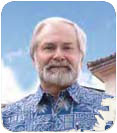

Message from the Director
Aloha from the Curriculum Research & Development Group, and welcome to our 2007 Year in Review. This year began with a host of challenges that, as the year progressed, became opportunities to return to our roots, celebrate our rich history, and revisit our foundations.
The University Laboratory School (ULS) has roots that go back over a century. The Castle family worked with John Dewey himself to build Castle Memorial Hall, which was modeled on the University of Chicago Laboratory School and was designed for training kindergarten and nursery school teachers. The one school soon grew to three, encompassing grades K through 12, their history and buildings intertwined with those of the College of Education. ULS underwent a transition in the 1960s, becoming an R&D laboratory for the newly organized Curriculum Research & Development Group (CRDG), an experiment based on the curriculum theory of King and Brownell and dedicated to the research and development of disciplinary curriculum that provides a rich liberal arts education for all students K–12. Our location in a university setting means that our research on K–12 education—arguably one of the most important focus areas for our nation’s and Hawai‘i’s future—is aided by the availability of an educational laboratory and enriched by the expertise of subject matter specialists on the university’s Mānoa campus.

Over the last 40 years CRDG has developed award-winning programs that accommodate a broad academic range in the classroom, starting with its flagship science program Foundational Approaches in Science Teaching (FAST). STEM (science, technology, engineering, and mathematics) programs have historically been our strength—there are currently 25 STEM projects in process at CRDG. Social studies and English texts on Asia and the Pacific have also distinguished our work, work that continued in 2007 with funding from $8.6 million in external grants and contracts.
As we reconnected with our foundations, planning for the future while reflecting on the past with the next generation of researchers, we were sustained by our partners, new and old—the collaborators and colleagues with whom we work locally, nationally, and internationally. Throughout the descriptions of our work that follow, you will see a celebration of the CRDG vision and of our many partners and supporters who share our mission to constantly improve education.
Dr. Donald B. Young
Director, CRDG
Kathleen F. Berg
Associate Director, CRDG
